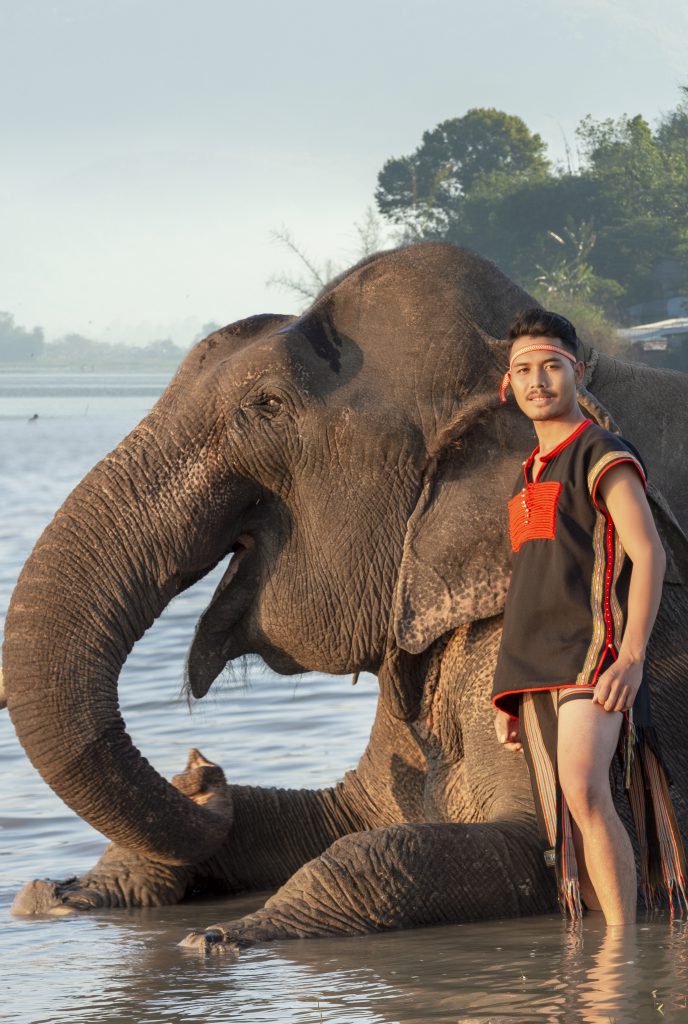Ninh Ton
When discussing the Central Highlands, the symbol that immediately springs to mind is the elephant — a beloved companion of the region’s indigenous communities.

In the past, any family in Vietnam’s Central Highlands that owned an elephant was highly respected within their village, enjoying elevated social status and honor. These majestic creatures were more than just property; they were cherished family members, given names, and lovingly cared for. Prior to the arrival of motorized vehicles, elephants were the main labor-power, responsible for heavy tasks such as pulling logs and transporting rice, corn, and potatoes. As integral participants in community activities and festivals, they were familiar figures, often seen in parades and games like elephant racing and soccer, or simply meandering by the lakeside, enjoying their breathtaking surroundings. Families would commonly hold biannual ceremonial rituals to pray for their elephants’ well-being, led by village elders well-versed in elephant behavior. The village elders would present ritual offerings and send earnest prayers to the deities on behalf of the hosts, asking for abundant health to be bestowed upon their elephants.

To delve deeper into the intertwined lives of elephants and their families, we spoke with Mr. Y’Vinh Êung, a member of the M’Nong ethnic group. As a renowned mahout from Le Village in the Lak district of Dak Lak province, he shared captivating stories of domesticating and raising elephants. The strong bond between humans and elephants in the Central Highlands came alive through his anecdotes. In 1994, when Y’Vinh was just eight, his family adopted a two-year-old male elephant from Don Village, whom they named Khăm Sen. Showered with love and nurtured in the most natural environment imaginable, Khăm Sen became an integral part of Y’Vinh’s family. They would guide him into the forest each day to forage freely for leaves and forest fruits, watching him from a distance. After many years of affectionate bonding and companionship, Khăm Sen was allowed to stay in the forest overnight. During the day, Y’Vinh’s family would supplement his diet with a variety of nutritious foods, such as bananas, sugarcane, and corn. Y’Vinh was entrusted with the important task of taming and training Khăm Sen. This process went smoothly, as Khăm Sen and Y’Vinh had spent many years growing up together amidst the vast forested mountains and the expansive Lắk Lake.

Y’Vinh could discern Khăm Sen’s health merely by observing his behavior, often serving as the most dedicated caregiver when the elephant fell ill. Now, at 29 years old, Khăm Sen and Y’Vinh have become popular figures in Le Village. Visitors wishing to observe Khăm Sen or other elephants will find it easy upon visiting scenic Lắk Lake. Witnessing these majestic animals firsthand for the first time, some tourists may feel intimidated and hesitant to approach them. Guides like Y’Vinh and other mahouts teach visitors how to greet the elephants, feed them, and pose for photos with them.
In earlier times, tourists visiting the Central Highlands – and Lắk Lake in particular – often wanted to take elephant rides. However, recognizing the potential impact on the elephants’ health and psychological well-being, such practices are now being curtailed. Instead, elephant owners have introduced alternative ways for visitors to interact with their elephants and gain understanding and respect for these creatures. Tourists can now feed and bathe the elephants and take photos with them. Many visitors, both domestic and from abroad, have embraced this shift toward more animal-friendly practices aimed at wildlife preservation. We remain hopeful that such elephant-friendly tourism experiences will continue to gain traction throughout the Central Highlands.

Trước đây, du khách đến Tây Nguyên nói chung và hồ Lắk nói riêng thường muốn cưỡi voi thì nay cũng hạn chế dần loại hình trải nghiệm này. Họ nhận ra rằng dịch vụ này ảnh hưởng đến sức khỏe, tâm sinh lý của voi. Thay vì cưỡi voi, một số chủ voi sẽ gợi ý cho du khách các hình thức để tìm hiểu, gần gũi loài động vật này như cho voi ăn, tắm cho voi, chụp hình lưu niệm cùng voi… Sự thay đổi theo hướng thân thiện với động vật này đã được nhiều du khách trong nước và quốc tế ủng hộ, mục đích hướng tới là bảo vệ các loài động vật hoang dã. Hy vọng rằng, các hoạt động trải nghiệm thân thiện cùng voi ngày càng được nhân rộng ở núi rừng Tây Nguyên.










